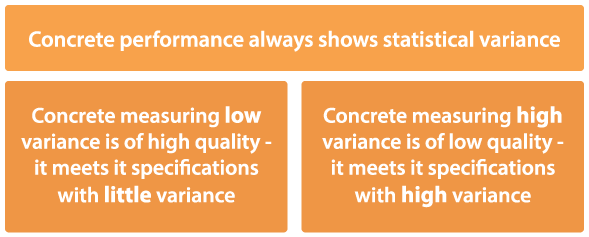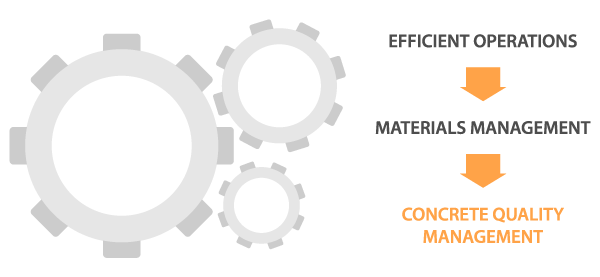Beyond Quality
Quality as a Competitive Advantage
The purpose of concrete quality management is to deliver products with consistent performance and at optimal cost, meeting customer expectations. Consistent performance is critically important to delivering cost optimal products to expectations, and key to using quality as a competitive advantage in the ready mix commodity business.

In the concrete industry, expectations are generally defined by a combination of engineering specifications, internal design, and cost criteria. Quadrel provides a comprehensive set of analytical, reporting, and quality evaluation tools covering specifications, fresh properties, strength and other hardened properties, as well as performance statistics per ACI procedures. As further explored under ACI Economics, inconsistent, high-variance quality can cost your business upwards of $0.25 to $1 pcy/yr, with additional significant costs from rejected concrete incidents. Low-variance, high quality products that consistently meet your customers’ expectation, will build loyalty and long-lasting relationships. Inconsistent, poor quality products, will put you at a competitive disadvantage, and lose you market share. Focus on what matters most, your customers. Leverage Quadrel’s many quality management tools to go beyond customer quality requirements, and set your own market differentiating standard.
Concrete Performance
Concrete performance is generally specified by the following factors:
- STRENGTH
expressed as a specified strength such as 5,000 psi (35 MPa) as 28 days, designated by the ACI symbol f'c
- For fast-track construction, often hi-early strength is specified for accelerated form removal, such as f'c=2,500 psi at 24 hours;
- For HCP (high performance concrete) or hi-strength or high-pozzolanic content concrete, which would be slow curing, delayed hi strength requirements are specified such as f'c=6,000 psi at 56 days.
- DURABILITY
use durability related tests such as RCP rates
- THERMAL SPECIFICATION
for thermal crack management and avoiding thermal distress
- FRESH PROPERTY REQUIREMENTS
- Rheological or flowability requirements such as slump and spread ranges;
- Air content range
- PRESCRIPTIVE REQUIREMENTS
- Maximum W/CM (water/cementitious) value for cases when durability is a concern;
- Maximum allowable cement replacement range;
- Minimum cement content
Quadrel provides tools for recording, tracking, statistically analyzing, and reporting all of the above requirements using many quality assessing tests. Quadrel also supports variable age f’c and automated ACI statistical analysis at any specified age f’c; for instance, you could have a mix f’c specified at 2,000 psi, 3,500 psi, and 6,000 psi at the respective ages of 1, 28, and 90 days. Quadrel handles f’c for MOR (modulus of rupture) in a similar manner, which is important for pavement construction.
ACI Economics
Concrete Strength and Quality Consistency
The key concrete quality metric is strength – usually at 28-days of age, but also at other ages. Concrete consistency is measured by the strength standard deviation or coefficient of variation (CV). Concrete strength, as well as all its other properties and attributes (including profitability), are always subject to significant statistical variability. This statistical nature of concrete is embedded in strength evaluation and mix design procedures such as ACI 318 (statistical mix design) and ACI 214 (statistical control charting and quality evaluation). In the commodity-driven ready-mix concrete markets, quality is the competitive differentiator that garners repeat orders, and therefore, customer loyalty.

Sub-quality, inconsistent concrete consumes more materials (especially expensive cement and chemicals), and is therefore more expensive to maintain than quality concrete. Low quality results in an inefficient utilization of materials, and operational inefficiencies. Quality significantly impacts cost of business, since more than 50% cost of ready mix business is cost of materials, and materials efficiency is quality dependent.
Low strength, high-variance quality is usually compensated for by adding costly cement. If the strength CV (coefficient of variation) increases from 12% to 13%, the increased cement cost per ACI criteria will range from around 1.5% to 3.5%, or on average 2.5%! Most businesses operate at CV values ranging from 15% to 17%, or they don’t even know what their CV value is. Good quality concrete should score a CV of less than 12%. Most businesses therefore are at least 3% over good quality concrete CV levels –this 3% excess is equal to saving more than 7% in annual cement costs!
Concrete consistency is measured by the strength, standard deviation, or coeficient of variation (CV). Good Quality concrete should score a CV of less than 12%
Don't let poor quality concrete slide by. If you do, then it's only a matter of time before you are hit by legal and remedial costs - effectively paying 6x your concrete's selling price.